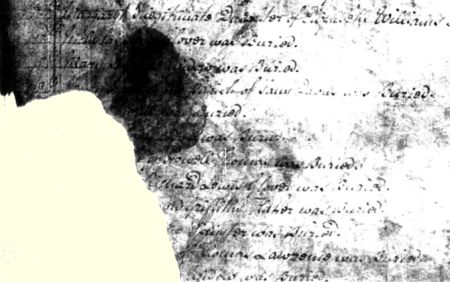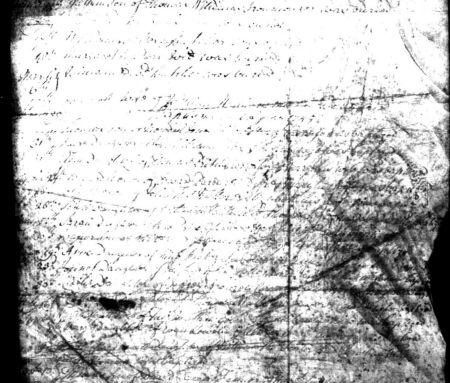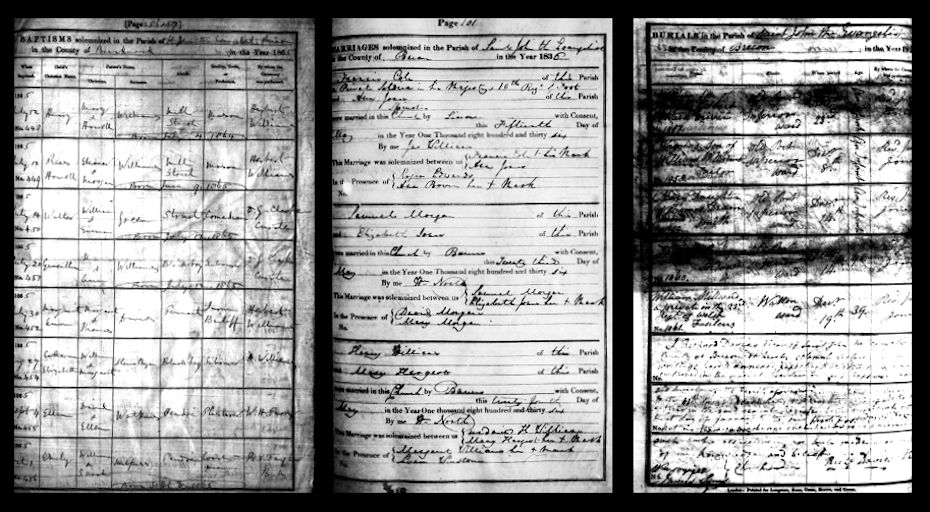Parish Pages - Brecon St John - Parish Records
Church of St John the Evangelist, Brecon: Bishop's Transcripts (1716-1868)
Introduction to the records
The BLFHS Transcription Group recorded the data found in digitised images of the Bishops Transcripts (BTs) of St John's parish records.
These Bishop's Transcripts are copies of the Parish Registers of the Priory church, the oldest place of worship in Brecon. They contain the records of the baptisms, marriages and burials of St John's parish itself and the burials of those from St Mary's parish too. These BTs have entries that are earlier than St John's parish registers, but they do have occasional missing years or parts of a year. As so many of the entries give the occupation or status of the people the BTS give an interesting insight into Brecon at that time. Our team transcribed the surviving Bishop's Transcripts of St John's parish held at the National Library of Wales.
For further information on the terms used for occupations see our guide to old occupations (PDF document).
For general information about Bishops Transcripts see our guide to using BTs (PDF document).
In the descriptions below, we have divided the St John's Bishop's Transcripts into two parts: the early records, written on loose pieces of parchment, and the later records, entered in standard record books.
1. Early Records: before 1813
The form of these records is very varied. Most of the yearly records are divided into three sections for baptisms, marriages and burials, but some have a mixture of types of record in date order. All the original transcripts were written on loose sheets of parchment of various sizes. Some documents suffer from fading, physical damage or staining (see examples below).


The standard and style of handwriting varies from scribe to scribe: legibility varies from one document to another and even within a document. Occasionally in these BTs the cleric who copied out the registers added a nickname of the person recorded, even substituting the nickname for the surname (see example below left). In a few entries extra details have been added (see example below right), but as these were in Latin and the handwriting poor, we have not been able to transcribe them fully. Most of these aliases and extras were written by Theophilus Evans, the promoter of the healing powers of the well at Llanwrtyd and grandfather of Theophilus Jones, Brecknock's historian.


The documents have been transcribed as seen, except that surnames are capitalised to aid searching and the date has been standardised to a simple form and is always at the beginning of an entry. Spelling mistakes and variants, for example, 'widdow' and 'sheomaker', and old forms of words such as 'ye' for 'the' have been retained.
Abbreviations used by the scribes have been expanded if they were not easily understood. Abbreviated names have always been expanded e.g. D[avi]d and Jno [John] and surnames such as THO[MA]S, DAV[I]D and W[ILLIA]MS. If looking for such surnames search using these expanded forms as well as the possible spelling variants of any surname.
The Transcripts of 1720 to 1730 were written in Latin or what the clerics remembered of the Latin taught in grammar school. Theophilus Evans continued to use the Latin abbreviation ux for wife in the English transcriptions and other clerics occasionally used a Latin term. For help with Latin see our guide to Ecclesiastical Latin (PDF document). The Latin Transcripts and all the Transcripts earlier than 1752 used the Old Style of dating years. After the new style calendar was introduced most of these early Bishop's Transcripts follow the church year and run from April to March. For help with interpreting these see our guide to the Old and New Style Calendar Years (PDF document).
2. Later Records: post-1813
All the later records are divided into Baptisms, Marriages and Burials, with a standard format for each; this enabled us to transcribe them into a spreadsheet (Microsoft Excel).
These records are in books; they are generally better preserved and clearer than the early records but some have become dark or faded, and not all have legiible handwriting. (see examples below)

An extra notes column has been added to the spreadsheet for information squeezed in by the cleric on the original record or for adding explanations. The penultimate column of the spreadsheet gives the page number of the original parish register from which the scribes copied the BTs. The final spreadsheet column (shaded pink) gives the identification number of the scanned image from which our transcribers worked.
Most of the St John's BTs give the place of residence of those recorded as one of the wards of Brecon town.